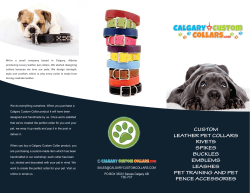
This article was originally published in Australian Stitches
This article was originally published in Australian Stitches magazine Vol 17 No 6. Permission for inclusion on this website has been granted by Express Publications Pty Ltd. Best-ever Shirt Collar and Stand By Lynn Cook For 30 years, I have been making my collars using the following method. I have passed it on to many of my friends and colleagues who now use this method to make perfect collars with stands as it is foolproof, ensuring the curved ends of the collar stand are identical. Plus, I have added a technique which allows your collar to stand up and never fall down; as in the case with most collars. We have colour-blocked the collar so you can easily follow the instructions. See photo 1. 2 1 Step 1 Cut out the collar and collar stand and interface as per the pattern instructions. Interface both the top and bottom collar and one collarstand only. It is at this point you will apply the new technique of reinforcing the back neckline. See the end of the article for this technique. Diagram 1 Step 2 Make the collar as per the pattern instructions and topstitch as required. See photo 2. Step 3 3 Make a small cardboard template approximately 5cm (2in) long, by following the curved edge of the collar-stand seam allowance on your pattern. See diagram 1. Attach the template with temporary adhesive or sticky tape to the interfaced side of the outer collarstand. Stitch around the template starting at the lower edge and finishing at the notch where the collar joins the collarstand. See photo 3. Step 4 4 Remove the template and repeat for the other end of the collarstand. Clip the curve and grade the seam line. See photo 4. Step 5 Turn through and press the curves making sure you have the seam line exactly on the edge. See photo 5. Step 6 Turn in the seam allowances along the collar opening and make sure they are exactly the same height. See photo 6. 40 Step 7 Now turn the collar-stand inside out again, place it upside down, and pull the shirt through the collar opening of the stand. With all notches and markings matching, pin the lower edge of the stand to the neckline of the shirt through all three thicknesses. See photo 7. 5 Step 8 Stitch in place, clip the curve of the neckline, and turn the stand back up into its finished position. See photo 8. 6 Step 9 Now for the fun part, take the finished collar and place it 1.5cm (5/8in) inside the opening of the collarstand. Make sure that both ends sit perfectly. This should be automatic if you have followed the marking and the notches of the pattern exactly. Now you have to pin both sides of the collarstand to the collar. As you pin, check to see that the collar stand on both sides of the collar is exactly the same. See photo 9. 7 Step 10 Now you can either do a row of hand-basting before you machine-stitch, or you can stitch in place, removing the pins as you go. I prefer to hand-baste and secure the fabric first. Step 11 Press the collar and stand and continue with making your garment following the pattern instruction sheet. 8 Reinforcing the collar See photo 10 If you want your collar to stand up at the back with a natural roll-line toward the front and not droop down after a few minutes of wear, this method is for you and it is so easy. 1. Mark the area to be stiffened onto your collar pattern. If the collar is high at the centre back, you may want to reduce the width of the collar by about 1cm (3/8in) in this area just as we have. See diagram 2. 9 Diagram 2 10 2. Take a piece of very crisp interfacing to use for the roll-line. Alternatively, you could use two or three layers of a medium-weight interfacing either fusible or non-fusible. 3. Cut out the curved crisp interfacing on Diagram 3 the bias grain using the diagram provided. This should measure approximately 22cm long x 5.5cm high (85/8 x 21/8in) for a size 14. Curve the sides to meet the bottom line as shown. See diagram 3. 4. Fuse the wrong side of the under collar with a suitable weight interfacing to complement your fabric as you would for a normal collar. Position the crisp interfacing curved piece over the under collar interfacing in the centre of the collar, using the centre back as a guide. Machinestitching this in place after fusing will add further strength. A decorative stitch may be used here, or simply stitch in straight rows following the shape of the curved interfacing. Finish stitching the collar as per the instructions. 11 41
© Copyright 2025




















